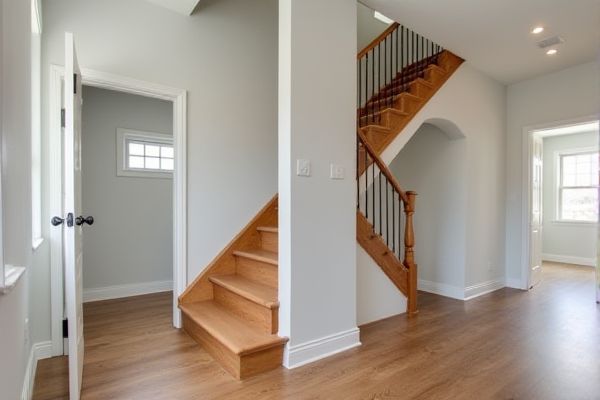
A dual-access staircase offers entry and exit points at both ends, improving flow and safety in buildings with higher occupancy, whereas a single-access staircase typically has one entry and exit point, making it suitable for smaller spaces but potentially less efficient during emergencies. Discover how choosing between these staircase types can impact your building's design and safety standards by reading the full article.
Table of Comparison
| Feature | Dual-Access Staircase | Single-Access Staircase |
|---|---|---|
| Access Points | Two entry/exit points | One entry/exit point |
| Traffic Flow | Improved bi-directional flow | Limited to uni-directional flow |
| Safety | Better evacuation routes | Potential bottlenecks in emergencies |
| Space Requirements | Requires more building space | More space-efficient |
| Construction Cost | Higher due to extra access point | Lower overall cost |
| Use Case | Large buildings, commercial complexes | Small buildings, residential units |
Introduction to Staircase Access Types
Dual-access staircases provide entry and exit points on two different floors or areas, facilitating enhanced traffic flow and emergency evacuation routes. Single-access staircases, commonly found in residential buildings, offer a straightforward design with one primary entry, suitable for limited space and lower foot traffic. Understanding the structural and functional distinctions between these staircase types aids architects in optimizing building safety and accessibility.
Defining Dual-Access and Single-Access Staircases
Dual-access staircases feature two separate entry or exit points, allowing greater traffic flow and improved evacuation routes in commercial or multi-residential buildings. Single-access staircases provide only one entry or exit, which may limit movement efficiency and pose challenges during emergencies. Choosing between these staircase types depends on building design requirements, occupancy levels, and safety regulations.
Space Efficiency: Dual vs. Single-Access Design
Dual-access staircases maximize space efficiency by providing entry and exit points at both ends, effectively reducing traffic congestion and optimizing flow in tight architectural layouts. Single-access staircases occupy less floor area but often create bottlenecks during peak usage, making them less suitable for high-traffic environments. In commercial and multi-story residential buildings, dual-access designs support better circulation while allowing more versatile furniture arrangements and functional use of adjacent spaces.
Safety Considerations in Staircase Choice
Dual-access staircases enhance safety by providing multiple egress points, reducing evacuation time in emergencies and minimizing crowding. Single-access staircases may create bottlenecks during high-traffic situations, increasing the risk of accidents and delays in escape. Prioritize your safety by choosing a dual-access design, especially in commercial or multi-occupancy buildings, to ensure efficient and secure movement.
Aesthetic Impact on Interior Architecture
Dual-access staircases create a striking visual centerpiece that enhances the flow and openness of interior architecture, making spaces feel more expansive and interconnected. Single-access staircases offer a streamlined and minimalist look, which can complement modern or compact interiors without overwhelming the design. Your choice influences not only the functional circulation but also the overall aesthetic harmony and spatial experience within the home.
Accessibility and User Flow Optimization
Dual-access staircases enhance accessibility by providing multiple entry and exit points, significantly improving user flow and reducing congestion during peak times. These staircases facilitate efficient movement in public and commercial buildings, ensuring smoother transitions between floors and minimizing wait times. Your building's traffic management benefits from the strategic placement of dual-access stairs, promoting safer and more convenient navigation for all users.
Cost Analysis: Initial Build and Long-term Maintenance
Dual-access staircases typically require a higher initial build cost due to increased materials and complex design, but they offer improved traffic flow that can reduce wear and tear over time. Single-access staircases have lower upfront expenses but may incur higher long-term maintenance costs due to concentrated foot traffic causing faster deterioration. Your choice should balance budget constraints with anticipated usage patterns to optimize overall lifecycle expenses.
Suitable Applications and Environments
Dual-access staircases are ideal for high-traffic commercial buildings, emergency exits, and public facilities requiring efficient crowd flow and safety compliance, providing separate entry and exit routes to minimize congestion. Single-access staircases suit residential buildings, small offices, and environments with limited space where simpler access and cost-efficiency are priorities. Choosing between dual-access and single-access depends on building occupancy, safety regulations, and spatial constraints to optimize usability and compliance.
Customization and Flexibility in Staircase Design
Dual-access staircases offer enhanced customization and flexibility by providing access from two different points, making them ideal for complex architectural layouts or multi-level spaces. Single-access staircases, while simpler, limit design options to one entry and exit, reducing adaptability in your home or building design. Choosing dual-access allows you to optimize traffic flow and tailor staircase placement to fit unique spatial requirements efficiently.
Final Considerations and Decision-Making Tips
Dual-access staircases enhance traffic flow and safety in high-occupancy buildings by providing multiple entry and exit points, whereas single-access staircases suit smaller spaces with less foot traffic. Evaluate building occupancy, emergency egress requirements, and available space before deciding; dual-access designs often increase construction costs but improve evacuation efficiency. Prioritize regulatory compliance and user convenience to optimize staircase functionality and safety in your architectural plans.
 homyna.com
homyna.com